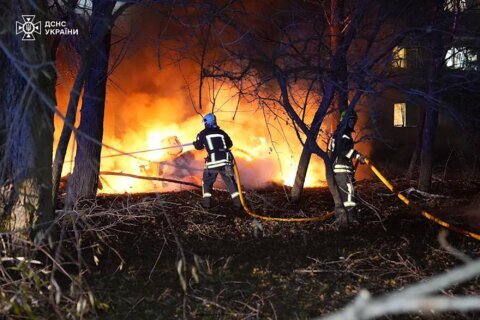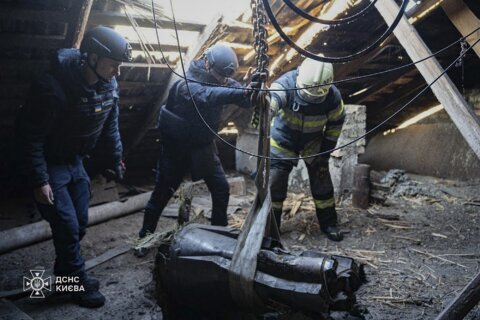KYIV, Ukraine (AP) — The fallout from the breach of a dam in southern Ukraine is wreaking havoc on lives, livelihoods and the environment amid the war.
When the Kakhovka dam ruptured on Tuesday, it sent a torrent of water from Ukraine’s largest reservoir into cities, towns and lowlands downstream on the Dnieper River, where fighting is raging.
It’s not clear what caused the breach in the dam, which had already been damaged in the war.
Ukraine’s government, which controls the river’s western bank and the city of Kherson, accused Moscow’s forces of blowing up the facility. Russia, which controls the eastern bank for about the last 300 kilometers (about 185 miles) before the river reaches the Black Sea, blames military strikes ordered by Kyiv.
Operational since the mid-1950s under the Soviet Union, the dam and its associated hydroelectric power station sit about 70 kilometers (44 miles) east of Kherson, and supply electricity, irrigation and drinking water to a wide swath of southern Ukraine and its residents.
WHAT ARE THE LATEST DEVELOPMENTS?
Authorities and rescue workers on both sides stepped up efforts to move beleaguered residents to higher and drier ground — although some complain of an uneven response.
The U.N.’s humanitarian aid agency warned that “the disaster will likely get worse in the coming hours.” It said access to drinking water and health risks associated with contaminated water were among the most pressing concerns.
About 3,000 people were evacuated from areas on both sides of the river, officials said.
Oleksandr Prokudin, head of the Kherson regional administration, said about 1,700 people had been evacuated in Ukraine-controlled areas as of Wednesday. Hundreds of calls for help were still flooding a government hotline, Prokudin said. The area has a population of about 42,000.
On the Russia-controlled bank, Moscow-appointed regional Gov. Vladimir Saldo said up to 40,000 people remained in flooded areas. His deputy, Tatyana Kuzmich, said 1,274 people had been evacuated, and that the emergency response would last at least 10 days.
U.N. spokesman Stephane Dujarric said nearly 12,000 bottles of water and 10,000 water purification tablets were distributed to five municipalities in Kherson and in Mykolaiv, where most of evacuees are staying. The U.N. also distributed ready-to-eat meals to about 400 people, he said.
WHAT REMAINS AT RISK?
The office of Ukraine’s general prosecutor said water levels downstream rose as much as 12 meters (39 feet) above normal.
Vladimir Rogov, an official with the Russia-appointed administration of the Zaporizhzhia region, said the Dnieper had narrowed Wednesday by as much as 65 meters as the reservoir drained.
The head of national hydroelectric company Ukrhydroenergo, Ihor Syrota, said authorities were holding water in upstream reservoirs to compensate in part for the loss of the dam.
Ukrainian President Volodymyr Zelenskyy wrote on Telegram that hundreds of thousands of people were without normal access to drinking water.
Experts warned about an environmental disaster for wildlife and ecosystems. Minefields were inundated, raising the prospect that the explosives could be dislodged.
Ukrainian authorities urged locals to drink only bottled water and avoid eating fish from the river.
HOW HAS RUSSIA RESPONDED?
Russian President Vladimir Putin, in a call Wednesday with his Turkish counterpart Recep Tayyip Erdogan, blamed Ukraine in his first comments on the incident. He said it was a “barbaric action” that “led to a large-scale environmental and humanitarian catastrophe,” a Kremlin account said.
Some residents in Russian-controlled areas criticized the response from the occupying authorities.
Yevhen Ryschuk, the Ukrainian mayor of Oleshky who fled the city after Russian forces occupied it, said locals told him that Russian authorities hadn’t mobilized evacuation efforts and had left many people stranded.
Ukrainian forces said they were reaching across the front line to help supply civilians in Russian-controlled areas.
Ukraine’s Defense Ministry tweeted a video showing a drone — presumably one of its own — dropping a bottle of water to a woman in a rooftop window in Oleshky. “The Ukrainian military will never leave civilians behind,” it said.
Zelenskyy wrote on Telegram that evacuation efforts in occupied areas had “completely failed.”
WHAT ABOUT THE IMPACT ON FARMING?
In a blow to one of the world’s biggest breadbaskets, Ukraine’s agriculture ministry said about 94% of irrigation systems in the Kherson region have been left without a water source, as well as nearly three-quarters of those in neighboring Zaporizhzhia and about 30% in Dnipropetrovsk.
“The destruction of the Kakhovka hydroelectric station will lead to the fact that the fields in the south of Ukraine next year can turn into deserts,” it said.
Prices for wheat and corn stabilized Wednesday after rising sharply a day earlier over concerns about Ukraine’s ability to ship its grain supplies to developing nations where people are struggling with hunger and high food prices.
___
Associated Press writer Edith M. Lederer at the United Nations contributed.
Copyright © 2024 The Associated Press. All rights reserved. This material may not be published, broadcast, written or redistributed.







